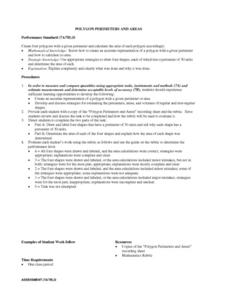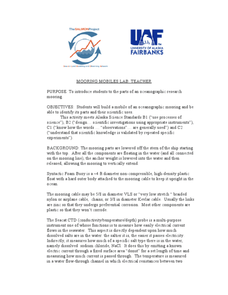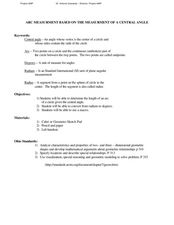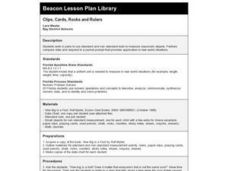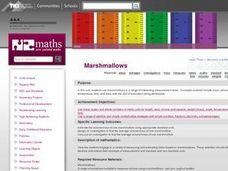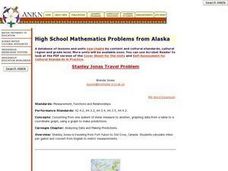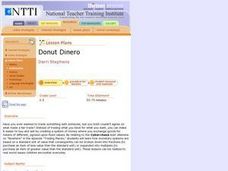Curated OER
Acid (and Base) Rainbows
Students are introduced to the differences between acids and bases and how to use indicators, such as pH paper and red cabbage juice, to distinguish between them. They make predictions that can be answered through scientific...
Curated OER
Principles of Flight: Flying Paper Airplanes
Students investigate ways to enhance an object's flying ability. In this model construction lesson, students construct two paper airplanes, one of which is twice as big as the first. Students compare and contrast the two separate...
Teach Engineering
Magnetic Fields Matter
Help your young scientists learn which materials are affected by magnetic fields with an activity that presents the information about different types of materials — diamagnetic, paramagnetic, and ferromagnetic — and their interaction...
Curated OER
Calculating Perimeter and Area of Polygons
Students discuss strategies for estimating information about various shapes. Once they draw and label four shapes with perimeters of 30 units, they calculate the areas of the figures. To complete the lesson plan, students offer written...
Curated OER
The Crash Scene
Fifth graders explore geography by participating in a mapping activity. In this engineering lesson plan, 5th graders identify the differences between latitude and longitude and practice locating precise points on a globe or map. Students...
Curated OER
Pancakes, Pancakes (Elementary, Science)
Read Pancakes for Breakfast by Tomi De Paola then participate in different activities which practice skills such as English language development, using non-standard measurement, fine motor skills, dramatic play, and using our five senses.
Curated OER
What Is Important to Me?
Students respond to prompt with awareness of personal value of possessions. They list the criteria used to determine worth and value. They listen and ask questions or add comments and check their own measures of value with those the...
Curated OER
Welina's World
Students living in Hawaii draw a picture of themselves in their neighborhood. They draw their neighborhood in relation to their district and then in relation to the island they are from. They compare their pictures to their classmates'...
Foreign Policy Research Institute
Understanding China: The Prospects for Democracy in China
This document provides useful information for a unit on democracy in China. While it does not include detailed activities, it does have a list of democratic principles, and important facts about China that facilitate understanding of its...
Curated OER
Mooring Mobiles Lab
Oceanography experts use candy to construct a model of a bio-physical mooring that would test a variety of factors. Each piece of equipment to be included on the mooring is described within the write-up. As pupils gather the candies for...
Curated OER
Aerobic And Anaerobic Activity
Third graders engage in the study of aerobic and anaerobic activities. They discuss the differences in the type of exercises involved. Students identify the types of activities they enjoy based upon the information given. Then students...
Curated OER
Arranging Patriotic Music for Instruments
Students arrange a short piano composition for a group of four to six instruments of their choice. The musical arrangements should be then demonstrated and analyzed by the class as a unit study.
Curated OER
Georgia CRCT Online
Prepare your class for a standardized exam with this language arts practice test. Designed for the Georgia Criterion-Referenced Competency Test (CRCT), these fifteen questions would be a great review for your seventh graders. Two...
Curated OER
Look at Those Leaves!
Young scholars observe and sort tree leaves. In this plant biology lesson plan, students observe various types of leaves and identify the characteristics of each leaf. Young scholars measure and sort leaves according to size and color.
Curated OER
Human Sexuality Unit
Eighth graders determine how mass media influences human sexuality by looking at advertisements for their sexual content and how the ads affect their decision making. After evaluating the advertisements in a PowerPoint presentation they...
Curated OER
Arc Measurement Based on The Measurement of a Central Angle
Students define keywords that are important to solve problems. In this geometry lesson, students find the arc length and angle of a circle. They convert between radians and degrees.
Curated OER
Triangle Attributes and Measures
Seventh graders explore the concept of triangles. In this triangles lesson, 7th graders sort triangles according to various attributes such as acute, obtuse, isosceles, or equilateral. Students find the area and perimeter of triangles.
Curated OER
Tonnage - Measurement
Students explore the size of one ton. They research the capacity of sialing ships and estimate the volume of rectangular prisms. Students perform activities to discover the capacity of a classroom in tons.
Curated OER
Clips, Cards, Rocks and Rulers
First graders use standard and non-standard tools to measure classroom objects. Partners compare data and responds to a journal prompt that provides application to real-world situations.
Curated OER
What's Your Wingspan?
Third graders measure each other's wingspan, and record and analyze the data.
Curated OER
Marshmallows
Third graders estimate the volume and mass of one marshmallow using appropriate standard units. They design and carry out an investigation to find the average of volume/mass of one marshmallow.
Curated OER
High School Mathematics Problems from Alaska: Stanley Jonas Travel Problem
Students convert from one system of linear measure to another, graphing data from a table to a coordinate graph, using a graph to make predictions.
Curated OER
Just a Little Bit
Second graders read the book, "Just a Little Bit" and work in groups weighing the same object with a scale. They then get a different unit of measurement, like paper clips, cotton balls, washers, or pennies and then figure out and record...
Curated OER
Donut Dinero
Students set up a classroom currency exchange and explore the idea of bartering to get what they want. They create a monetary unit that is based on fractions and multiples of a standard unit, and compare this system to the U.S. monetary...





